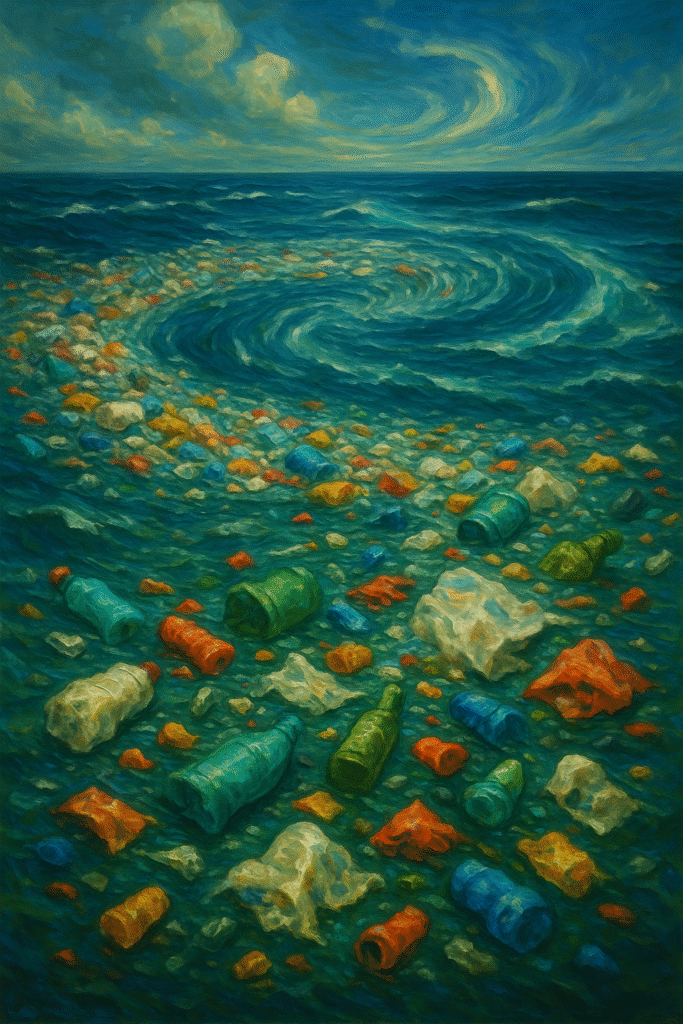In the vast expanse of the North Pacific Ocean lies a significant environmental challenge – the Great Pacific Garbage Patch (GPGP), also commonly referred to as the Pacific Garbage Patch. This colossal accumulation of marine debris, primarily composed of plastics, is not merely a striking visual phenomenon; it is fundamentally altering the very dynamics of ocean currents, with far-reaching consequences for marine ecosystems that we are only starting to comprehend. Understanding how the Great Pacific Garbage Patch is changing ocean currents helps illuminate the broader implications of plastic pollution for our oceans and our planet as a whole.
What Is the Great Pacific Garbage Patch?
The Great Pacific Garbage Patch is a massive area in the North Pacific Ocean where plastic and other debris converge and accumulate due to specific ocean currents. Spanning approximately 1.6 million square kilometers, it has become a key area of study in oceanography and serves as a stark symbol of the effects of plastic pollution on our oceans. This concentration of marine debris has profound repercussions not only for ocean currents but also for marine life and climate patterns. As we delve deeper, it is clear that the Great Pacific Garbage Patch represents a critical moment in our relationship with the ocean.
The Composition of the Great Pacific Garbage Patch
A significant portion of the material found in the Great Pacific Garbage Patch consists of microplastics—tiny plastic particles measuring less than five millimeters in diameter. These particles are often the result of larger plastic items breaking down and are extremely harmful to marine ecosystems. In addition to microplastics, larger debris such as fishing nets and various types of discarded plastics contribute to this accumulating hazard, causing severe risks to marine organisms. The density and spread of these particles vary, influenced by wind patterns and ocean currents, making the GPGP a complex and dynamic environment that presents unique challenges for ocean health.
How the Great Pacific Garbage Patch Affects Ocean Currents
Ocean Currents Impact
The impact of the Great Pacific Garbage Patch on ocean currents unfolds in several critical ways:
1. Altered Currents: The sheer volume of debris can impede and redirect the natural flow of ocean currents. This alteration has cascading effects on weather patterns and climate systems. For example, alterations in the Gulf Stream due to marine debris can indirectly influence temperature patterns across the Atlantic Ocean.
2. Ecosystem Disruption: As marine organisms become entangled in plastic or accidentally ingest microplastics, the health of the entire oceanic ecosystem deteriorates. This not only leads to decreased biodiversity but also results in habitat destruction and disruptions to the food chain, creating a trickle-down effect that threatens the stability of marine life.
3. Transport of Pollution: The Great Pacific Garbage Patch acts as a vehicle for a range of pollutants, including chemical contaminants. These harmful substances can spread across vast ocean regions, further threatening marine life and potentially posing risks to human health through the food chain.
Exploring the Effects of the Great Pacific Garbage Patch
The environmental impact of the Great Pacific Garbage Patch is sobering and multifaceted. Sea turtles that mistake plastic bags for jellyfish or seabirds that ingest microplastics often face life-threatening consequences. Beyond individual species, the entire spectrum of the marine ecosystem is vulnerable. Coral reefs can suffer from changes in water quality and temperature due to altered currents, leading to widespread coral bleaching—this emphasizes the interconnectedness of ocean health and the health of the Great Pacific Garbage Patch.
Frequently Asked Questions About the Great Pacific Garbage Patch
How Is the Material in the Pacific Garbage Patch Distributed?
The material in the GPGP is distributed unevenly, with microplastics being the predominant component. Factors such as wind strength, water temperature, and ocean currents influence the density and spread of these particles. Larger debris, including fishing nets and commercial waste, poses additional threats, particularly to larger marine life that may become entangled. Understanding this distribution is vital for effective cleanup and mitigation efforts.
What Are the Long-Term Effects of the Great Pacific Garbage Patch?
The long-term effects of the Great Pacific Garbage Patch are extensive and alarming:
* Depletion of Marine Resources: The patch disrupts the habitats of fish and other marine life, which has significant consequences for food supply chains and the fishing industry. The economic ripple effects can be monumental, striking at local economies reliant on aquatic resources.
* Impact on Climate Change: Changes in ocean currents due to the GPGP can contribute to broader climate change impacts, affecting weather patterns in surrounding coastal regions and potentially impacting global atmospheric conditions.
What Can Be Done to Mitigate the Impact of Plastic Pollution?
Effective mitigation strategies against the impact of plastic pollution require action on multiple fronts. Here are several actionable steps:
1. Reduce Plastic Use: Individuals can significantly reduce their plastic consumption by opting for reusable alternatives instead of single-use plastics. Making conscious choices to buy products with less packaging can create substantial waves of change.
2. Support Cleanup Initiatives: Engaging in or financially supporting organizations committed to cleaning up ocean waste is crucial for addressing existing contamination. Collaborative cleanup events can also raise community awareness about the importance of ocean conservation.
3. Advocate for Policy Changes: Supporting legislation aiming to reduce plastic waste and address pollution can lead to broader systemic change. Advocating for policies promoting sustainable practices within businesses and communities is essential for long-term solutions.
Future of the Great Pacific Garbage Patch and Ocean Health
The road ahead in combatting the immense problem of the Great Pacific Garbage Patch demands a collaborative effort between governments, organizations, and individuals alike. Innovative solutions are increasingly necessary, such as improving waste management practices and developing advanced cleaning technologies. Research into the marine ecosystem’s response to pollution is also imperative. Ongoing oceanographic studies are essential to fully understand, monitor, and address the complex interactions between plastic pollution and ocean currents. By forging partnerships and undertaking innovative projects, we can establish effective ocean conservation strategies to secure a sustainable future.
Conclusion
Understanding how the Great Pacific Garbage Patch is changing ocean currents offers crucial insight into broader environmental challenges. The intricate connections between pollution, marine health, and climate patterns underscore the need for immediate action. By establishing a proactive approach to ocean conservation and sustainability, we can cultivate an oceanic environment that thrives both now and in the future. Let’s set aside apathy and truly embrace our role as environmental stewards, taking meaningful action today to protect our oceans for generations to come.


